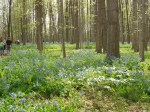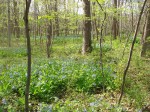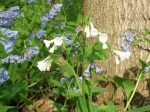The Capital District Friday Field Group has been going on some nice field trips since April. You can see their plant lists HERE and photos they took HERE. Every week we hear the common phrase of 2012, “This is blooming already!”
Archive for the ‘What’s Blooming’ category
Stay Abreast of Friday Field Group Trips
June 2, 2012Breaking news: Skunk Cabbage Seen Flowering in Dutchess County
March 10, 2011NYFA board member Aissa Feldmann saw skunk cabbage blooming in a swamp at Stony Kill Farm near Beacon in Dutchess County on March 9th while performing surveys for New England cottontail. The snow was patchy (see photo) so she didn’t see the process of snow melting that characterizes these flowers. Spring is on the way!
Plants Are Starting to Bloom!
April 2, 2010The Snowdrops Are Up in The Capital District
March 25, 2010A sure sign of spring is the appearance of snowdrops in mid-March in our area. Even though it is not a native (from the Mediterranean region to the Caucasus Mountains) it is still good to see something green coming out of the ground. The Wall Street Journal published an article recently about some people’s obsession with snowdrops. See it HERE. Now we can keep our eyes out for coltsfoot although there are reports of it up Saratoga way. See the Saratoga Woods Blog on the sidebar. – Steve Young
See a video of how to identify snowdrops.
Lots Blooming on the Saratoga Woods and Waterways Blog
July 18, 2009Check out all of the beautiful photographs of plants blooming along the upper Hudson River this time of year. Click the link in our list to the right.
What’s Blooming in Central New York Fens.
June 1, 2009Patrick Raney, a PhD student at SUNY ESF in Syracuse is monitoring fen plots in Central NY and getting around to all of his plots every 2 weeks. Here is his recent phenology data for these plots. Thanks Patrick!
In bloom:
Central Square sedge meadow & red maple swamp:
5-27-09
Carex stricta
Cypripedium acaule
Cypripedium parviflorum
Rhamnus alnifolia
Geum rivale
Carex crinita
Cornus sericea
Photinia melanocarpa
Vaccinium corymbosum
Fertile fronds on Osmunda cinnamomea
Viola cucullata
Saxifraga pensylvanica
Nelson Swamp 5-25-09
Cypripedium parviflorum
Trillium cernuum
Mitella nuda
Mitella diphylla
Clintonia borealis
Aralia nudicalis
Maianthemum stellata & candensis
Calla palustris
Fertile fronds on Osmunda claytoniana
Viola cucullata
Saxifraga pensylvanica
Beaver Creek State Forest Fen: 5-28-09
Corallorhiza trifida
Geum rivale
Clintonia borealis
Mitella nuda
Saxifraga pensylvanica
Hannacroix Ravine Plants in Flower on May 15, 2009
May 19, 2009The Capital District Friday Field Group visited the TNC Hannacroix Ravine Preserve in Clarksville last Friday May 15, 2009. Bob Ingalls sent along this list of plants they saw in bloom.
Aquilegia canadensis – Columbine
Barbarea vulgaris – Yellow Rocket
Cardamine diphylla – Toothwort
Cardamine pensylvanica – PA bittercress
Carex communis – communal sedge
Carex deweyana – Dewey’s sedge
Carex gracillima -graceful sedge
Carex laxiflora – broad loose-flowered sedge
Carex pensylvanica – PA sedge
Carex playtphylla – broad-leaf sedge
Carex tonsa var tonsa – shaved sedge
Fragaria virginiana – strawberry
Geranium robertianum – herb Robert
Luzula campestris – common wood-rush
Maianthemum canadensis – mayflower
Maianthemum racemosum – false Solomon’s seal
Polygonatum pubescens – Solomon’s-seal
Prunus virginiana – chokecherry
Ranunculus abortivus – small-flowered crowfoot
Ranunculus recurvatus – hooked buttercup
Ribes cynosbati – wild gooseberry
Ribes rubrum – northern red currant
Sambucus racemosa ssp. pubens – red elderberry
Thalictrum dioicum – early meadow-rue
Tiarella cordifolia – foam flower
Viola conspersa – American dog violet
Viola pubescens – downy yellow violet
Viola rostrata – long-spurred violet
Viola saggitata – arrow-leaf violet
Viola sororia – common blue violet
Waldsteinia fragarioides – barren strawberry
Mertensia City
May 5, 2009In Western New York, Karen Schreiner reported on the Genesee Valley Conservancy annual bluebell walk that they host every year. It’s near the Genesee River, on 400+ acres of easement protected property. She refers to it as Mertensia City. Her photos below show how beautiful it is. -Steve Young
- Mertensia City
- The footpath through the bluebells
- The bluebells’ habitat
- White-flowered bluebells
National Phenology Network website
April 29, 2009Besides the Central New York effort described below there is a national effort to monitor phenology. From their website – The USA National Phenology Network brings together citizen scientists, government agencies, non-profit groups, educators and students of all ages to monitor the impacts of climate change on plants and animals in the United States. The network harnesses the power of people and the Internet to collect and share information, providing researchers with far more data than they could collect alone. To join the network go to:
Visit Project Budbreak
April 28, 2009What is Project Budbreak? The web site has been established to help citizen scientists observe the effects of climate change on native plants in central New York.
Associated with a national effort, a network of citizen scientists is being established in central New York to observe the timing of flowering, leaf development, fruiting, and leaf drop in populations of common native trees and herbaceous species. This site will help observers to enter their data on the timing of important plant events through the growing season.
After registering as a participant, you will set up 1 or more sites that you will be observing regularly. For each site, you will set up 1 or more individual plants for which you will periodically record phenological data. – Information from the budbreak website.
You can find it at http://budbreak.tc.cornell.ed











